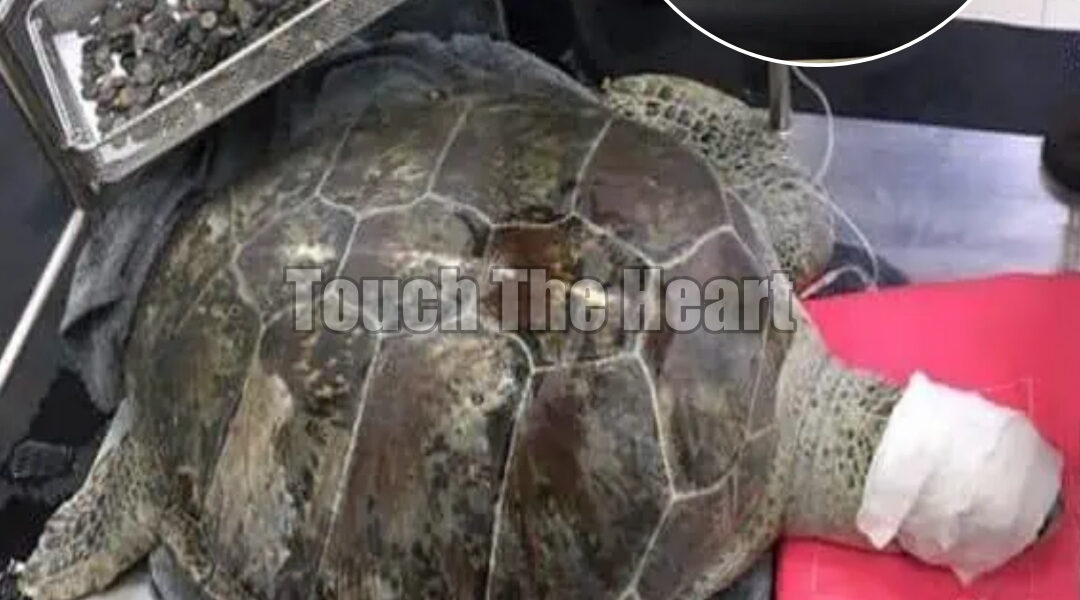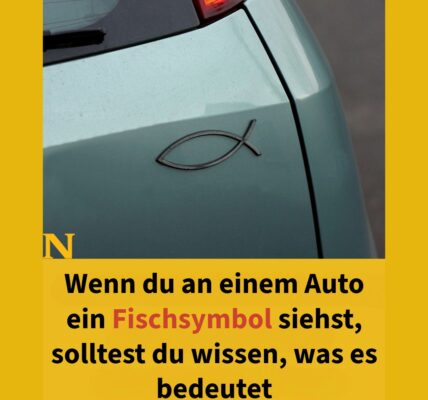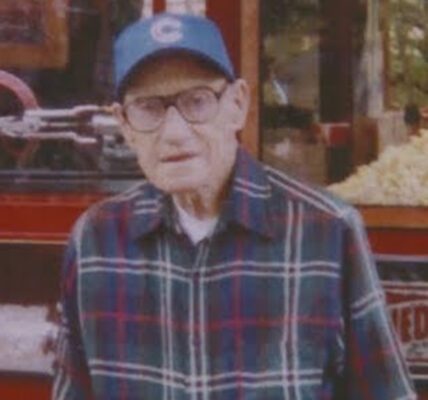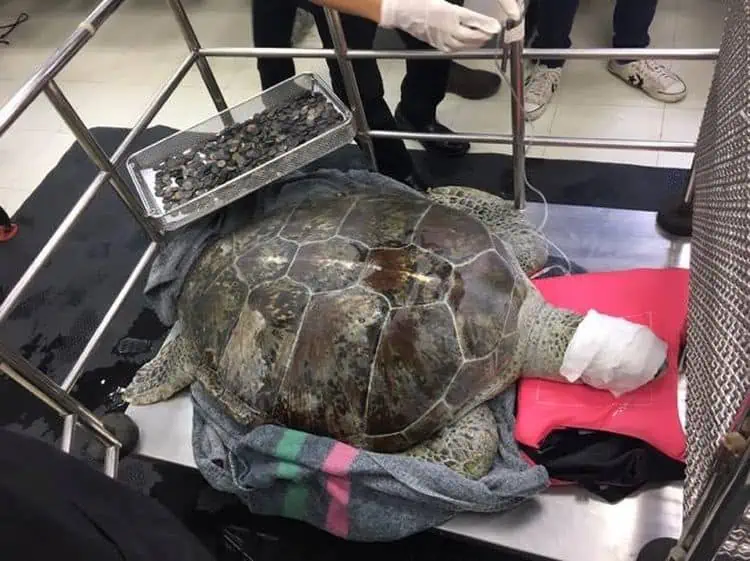
In a quiet pond near Bangkok, Thailand, tourists once gathered to make a wish. They tossed coins into the water, each one carrying a silent hope — for health, wealth, love, or luck. The coins shimmered as they sank, a glittering mosaic beneath the surface.
But beneath that shimmer lived a turtle named Omsin — “Piggy Bank” in Thai — who would come to carry the weight of those wishes in the most heartbreaking way.
For twenty-five years, Omsin swam through that pond, gliding slowly under the watchful eyes of visitors. She was a green sea turtle, gentle and ancient, a symbol of good fortune in Thai folklore. People believed that tossing coins toward her would bring them longevity and happiness. They didn’t know that, with each wish, they were slowly taking hers away.
The Weight of Wishes

Over time, Omsin began to change. Her movements grew slower. She stopped diving deep. She floated awkwardly, her shell dipping unnaturally in the water. Caretakers at the conservation center noticed she wasn’t eating much anymore.
When veterinarians examined her, they discovered the unthinkable: her stomach was filled with coins. Not one or two — but hundreds.
Each coin, tossed with good intentions, had settled in her belly, clinking softly inside her as she swam. What had once been a pond of luck had become a prison of metal.
The coins had grown into a solid mass, pressing against her organs, stealing her strength. She could no longer swim properly. The very wishes that people hoped would bring happiness had nearly killed her.
The Unimaginable Surgery

A team of veterinarians at Chulalongkorn University in Bangkok prepared for what would become one of the most extraordinary surgeries in the world.
Under the leadership of Dr. Nantarika Chansue, the team carefully anesthetized Omsin and began the long, delicate operation. They made a small incision at the bottom of her shell — only to discover the coins packed tightly, layer upon layer, like the scales of armor.
They couldn’t remove them all through the first incision. So, they carefully cut into her stomach, working methodically, gently, removing one coin after another.
The surgery lasted seven hours. When it was over, the pile of metal on the operating table gleamed under the hospital lights — 915 coins in total. Together, they weighed nearly five kilograms — eleven pounds of metal inside a turtle who weighed only fifty-nine.
The room fell silent as the last coin was lifted out.
Omsin’s caretakers wept softly. One of the vets whispered, “She’s carried people’s wishes long enough. It’s time she has her own.”

The Long Road to Healing
After the surgery, Omsin was placed in intensive care. Her breathing was shallow, her movements weak. The incision beneath her shell was stitched carefully, and she was watched around the clock by the veterinary team who had saved her.
Each day, she showed small signs of recovery. She began to eat again. She started to move her flippers with a little more strength. Her caretakers celebrated every small improvement — every bite, every stretch, every moment she lifted her head toward the surface.
The nurses joked gently, calling her “our lucky turtle,” though they knew luck had little to do with her survival. It was compassion — and science — that gave her another chance.
The Lesson Beneath the Surface

When news of Omsin’s surgery spread, the world was stunned. Photos of the mound of corroded coins — a mountain of human greed disguised as hope — went viral. People were shocked to realize that their innocent traditions could carry such cruelty.
Dr. Rungrote Thanawongnuwet, a leading marine expert at Chulalongkorn University, explained:
“People believe throwing coins at turtles brings them longevity and good fortune. But these turtles die before their time because of it. This isn’t merit. It’s harm.”
His words struck deeply. In Thailand, turtles are seen as sacred creatures — symbols of wisdom and endurance. Yet here was a turtle whose body had been filled with the very thing humans thought would bless her.
Omsin’s suffering became a mirror — reflecting the unintended consequences of human ignorance.
The Turtle Who Carried Our Sins
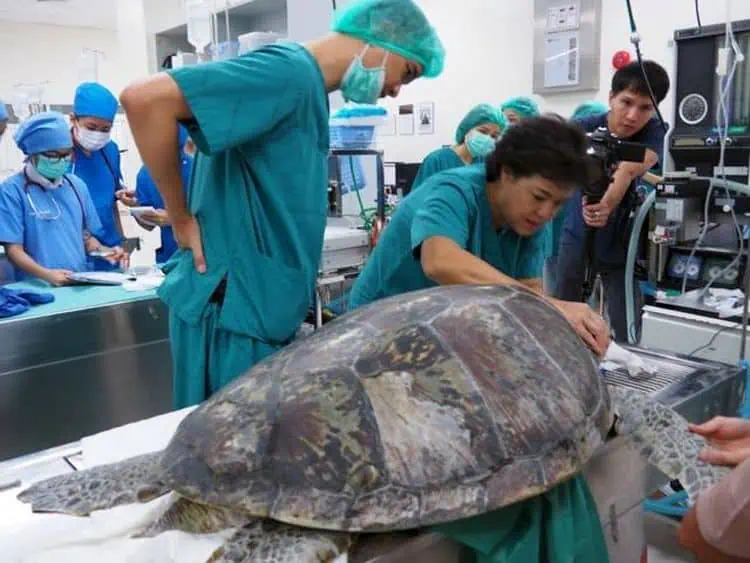
For the next several weeks, Omsin continued her recovery. Her keepers spoke to her softly, cleaning her wounds, feeding her carefully measured meals, celebrating every sign of progress.
When she finally began to swim again — slowly, gracefully — there were tears in the room. After so many years of pain, she moved freely once more, her body lighter, her spirit unburdened.
Her story reached far beyond Thailand. Conservationists across the world began campaigns urging people to stop throwing coins into ponds, fountains, and temple pools. Signs went up:
“Wishes don’t need to sink to come true.”
But despite her recovery, Omsin’s body bore the toll of decades of damage. The surgery had saved her life, but it could not erase all the harm.
Months later, as her caretakers watched over her one quiet morning, Omsin’s breathing slowed. Her heart gave out peacefully, surrounded by the very people who had fought to give her freedom.
Her death was met with sadness — but also purpose. She had lived long enough to teach the world something vital: that kindness without understanding can still cause harm.

The Ripple She Left Behind
Today, Omsin’s story lives on in classrooms, conservation programs, and awareness campaigns around the world. She is remembered not just as a victim, but as a messenger — a gentle creature who carried humanity’s wishes, and in doing so, revealed the weight of our thoughtlessness.
Her surgeon, Dr. Nantarika, said it best:
“She carried our sins, not our luck. If her suffering can stop others from doing the same, then her life — and her death — will have meaning.”
In the quiet ponds of Thailand now, signs stand where once only ripples formed. They remind visitors that real blessings come not from tossing coins, but from caring for the world that holds us all.
And somewhere, perhaps in the unseen depths of the ocean, a thousand wishes rise and fall with the tide — lighter now, free of metal, free of harm — carried by the memory of a turtle named Omsin, who once bore the weight of human hope and taught the world to wish more gently.
